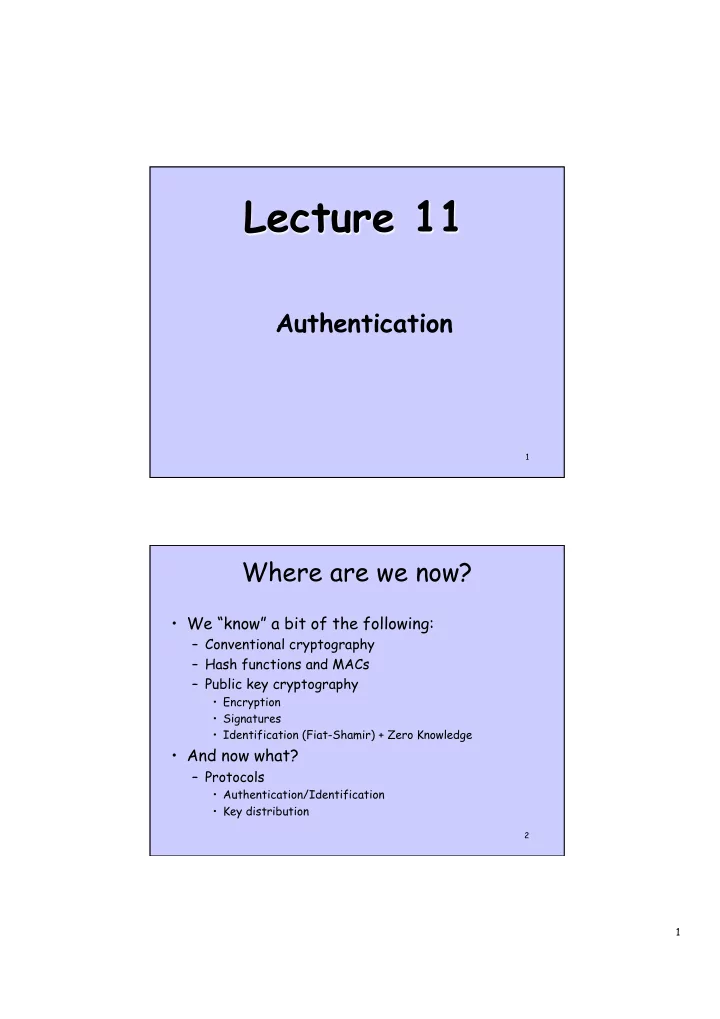

Lecture 11 Authentication 1 Where are we now? • We “know” a bit of the following: – Conventional cryptography – Hash functions and MACs – Public key cryptography • Encryption • Signatures • Identification (Fiat-Shamir) + Zero Knowledge • And now what? – Protocols • Authentication/Identification • Key distribution 2 1
Secure Protocols • A protocol is a set of rules for exchanging messages between 2 or more entities • A protocol has a number of rounds (>1) and a number of messages (>1) 1. Hello Bob! 2. Good day, Alice! 3. How are you? 3 Secure Protocols • A message is a unit of information send from one entity to another as part of a protocol • A round is a basic unit of protocol time: 1. Wake up because of: a) Alarm clock b) Initial start or c) Receive message(s) from other(s) 2. Compute something 3. Send message(s) to others 4. Repeat steps 2-3, if needed 5. Wait for message(s) or sleep until alarm clock 4 2
What ’ s a secure protocol? • When acting honestly, entities (participants) achieve the stated goal of the protocol, e.g.: – A successfully authenticates to B, – A and B exchange a fresh session key • Adversary can defeat this goal – e.g., by successfully impersonating A in an authentication protocol with B 5 The Entities (2-party setting) • Alice and Bob – want to mutually authenticate and/or share a key • Eve , the adversary – passive or active • In more complex protocols, TTP – 3 rd party trusted by both Alice and Bob 6 3
Definitions • Entity authentication: – corroboration that an entity is the one claimed. • Unilateral authentication: – entity authentication: providing one entity with assurance of the other’s identity, but not vice versa • Mutual authentication: – entity authentication which provides both entities with assurance of each other’s identity 7 Purpose Examples: Ø Bank transactions, e.g., cash withdrawals Ø Remote login Ø File access Ø P2P transaction Has user’s secrets TTP Send secret or prove knowing it? Peer Doesn’t Or Server 8 4
Basis for Authentication • Something you know (a PIN, or password). • Something you have: – A secure token, e.g., that generates a one-time password. – key embedded in a “secure area” on a computer, in browser software, etc. – a smartcard (which may contain keys and can perform cryptographic operations on behalf of a user). • Something you are (a biometric). 9 Concrete Scenarios v PIN-, PW-, Biometric-based schemes v Kerberos (covered later) v SecureID tokens v Iris/retina scanners v Thumbprint & Handprint v Handwriting acceleration & pressure v Public Key Identification Schemes: v Fiat-Shamir, etc. v Authentication protocols v conventional- and public key-based (covered later) 10 5
Human Failings v Humans are notoriously unreliable v Human memory is very volatile storage What a human can remember: v PIN (no more than 6-8 digits) v Password (a word or a short phrase) v Can a human do single-digit sums? Forget it… 11 Biometrics • Accuracy: – False acceptance rate. – False rejection rate. • Retinal scanner, fingerprint reader, handprint reader, voiceprint, keystroke timing, signature (shape or pressure), etc. 12 6
Fingerprints • Vulnerability: – Dummy fingers and dead fingers • Suitability and stability: – Not for people with high probability of damaged fingerprints (e.g., exema) – Not for kids who are still growing 13 Voice Recognition • Single phrase: – Can use tape recorder to fake • Stability: – Background noise – Colds, vocal cord damage/strain, laughing gas J – Use with public phones 14 7
Keystroke Timing • Each person has a distinct typing timing and style – Hand/finger movements • Suitability: – Best done for “local” authentication • Avoid network traffic delay 15 (non-digital) Signatures • Machines can’t match human experts in recognizing shapes of signatures • Add information on acceleration and/or pressure – Signing on a special electronic tablet 16 8
SecureID 89458920 display power 895980390409982 TTP/Server: secure & knows all secrets! Id-based key (inside) Serial # 17 9
Recommend
More recommend